Tivoli Day Trip from Rome – Hadrian’s Villa & Villa d’Este | Romewise
VIDEO
Wondering what a Tivoli day trip is all about?
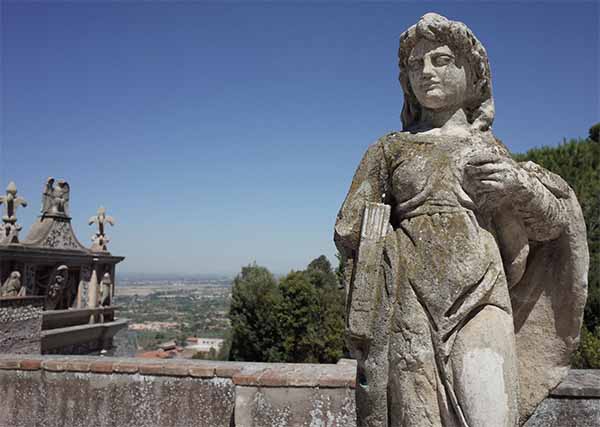 Man-made and natural beauty abound in Tivoli – the perfect day trip from Rome!
Man-made and natural beauty abound in Tivoli – the perfect day trip from Rome!The town of Tivoli, just outside of Rome, is a must-see spot.
Whether you’re interested in ancient history, beautiful gardens, or if you’re just looking to escape the crowds, there is something here for you.
Everything you need to know about taking a Tivoli day trip from Rome
Tivoli is a popular destination for tours and a great day trip from Rome.
I love the area, and have been visiting ever since my early trips to Rome over a decade ago!
The ancient Roman archeological site of Villa Adriana is my personal favorite place to visit, but the stunning fountains and gardens of Villa d’Este come a close second.
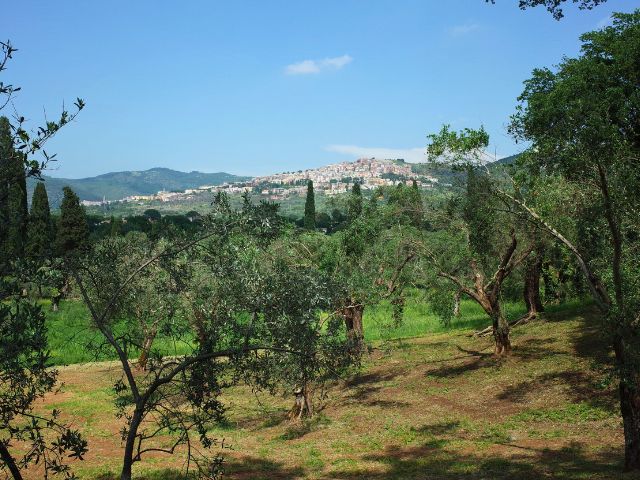 The hillside town of Tivoli as seen from Hadrian’s Villa – not a bad view!
The hillside town of Tivoli as seen from Hadrian’s Villa – not a bad view!Close enough to Rome to make it one of the easier day trips to take, Tivoli has a lot to offer visitors.
To find out everything you need to know about Tivoli day trips, keep reading.
On this page we’ll be covering:
Follow Elyssa in this YouTube video as she explores Hadrian’s Villa and Villa d’Este on a fun day trip from Rome!
Why visit Tivoli?
Is Tivoli worth visiting? Absolutely!
Tivoli is home to not one, but two UNESCO World Heritage sites, Hadrian’s Villa (Villa Adriana in Italian) and Villa d’Este.
It is possible to visit both villas in the same day, either by yourself or as part of a guided tour.
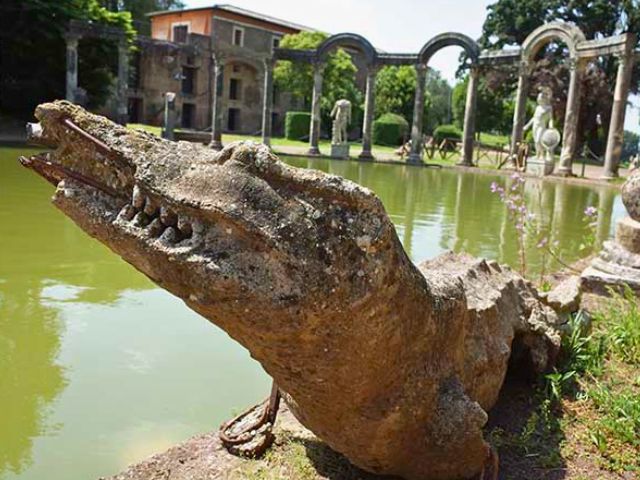 Plenty of surprises await visitors to Tivoli on day trips from Rome!
Plenty of surprises await visitors to Tivoli on day trips from Rome!Tivoli sits on the side of a large hill, from which natural freshwater springs flow.
This creates a series of waterfalls which are visible from the historic center and the surrounding local area.
Throughout Tivoli you’ll find numerous Roman ruins, and on the outskirts there are remains of ancient aqueducts, along with several hiking and cycling routes.
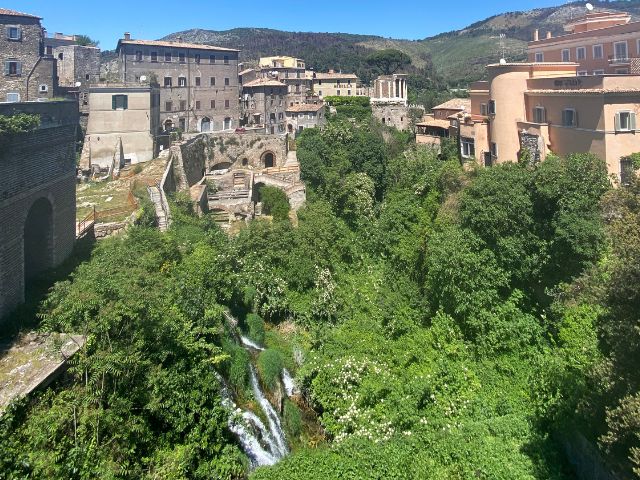 Tivoli’s freshwater springs were no doubt a draw for the area’s first settlers, and now make for an incredible sight!
Tivoli’s freshwater springs were no doubt a draw for the area’s first settlers, and now make for an incredible sight!Where is Tivoli in relation to Rome?
Tivoli is located 27km (as the crow flies) from the center of Rome.
Villa d’Este is in the center of the modern town, whereas Villa Adriana is located on the outskirts.
How to get from Rome to Tivoli
Getting to Tivoli from Rome couldn’t be easier.
You have a couple of options for a self-guided day trip:
Public transportation
The most direct route to the main sights of Tivoli from the center of Rome is to take the Metro Line B (blue line) to the Ponte Mammolo station, and then a bus.
When you step out of the Ponte Mammolo station, you will see a number of buses from a company called Cotral.
From here, you can take any of the buses marked as heading to Tivoli.
- One of the buses takes a more winding route, stopping around 300m from the entrance to Villa Adriana before heading into Tivoli. This bus runs much less frequently.
- The other bus routes are more direct – if you are visiting Hadrian’s Villa you will need to get off at the stop on via Tiburtina and walk around 2km to reach the entrance.
There are also various trains that stop in Tivoli from the central Rome station of Termini, but the Tivoli train station is located at the bottom of the hill.
To reach the various sights, you will need to then take a local bus, or you can walk – it’s around a 25 minute uphill walk.
The local bus also goes to Hadrian’s Villa.
Driving
To drive to Tivoli from the center of Rome takes between 45 minutes and an hour, depending on where you set off from.
If you’re heading to Hadrian’s Villa there is plentiful and cheap parking on site.
You need to pay for parking at the ticket office when you buy your tickets to the archaeological park, or redeem your pre-booked tickets if you booked on line tickets.
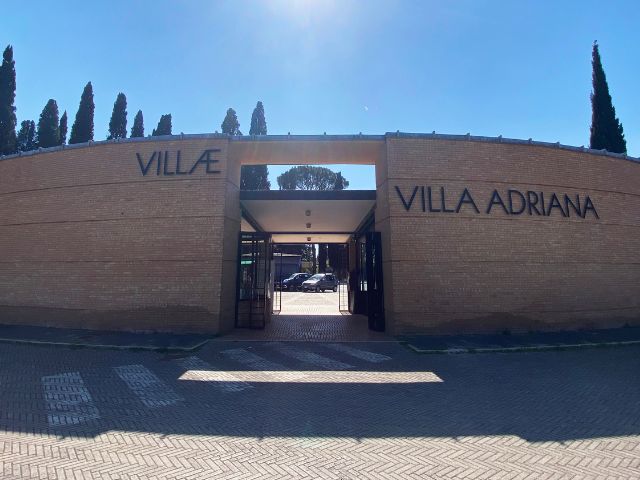 You can’t miss the modern entrance to Hadrian’s Villa on arrival, here you’ll find bathrooms, the ticket office and a gift shop.
You can’t miss the modern entrance to Hadrian’s Villa on arrival, here you’ll find bathrooms, the ticket office and a gift shop.Driving to Villa d’Este is a little more difficult as there is no official car park, but there are several options nearby.
You can park on one of the side streets nearby where you’ll need to pay at one of the machines along the sidewalks (pay close attention to the time frames and conditions) or in one of the official car parks listed below.
For the historic center of Tivoli in general if you’re wanting to see the waterfalls or other historical landmarks, I’d recommend parking in this carpark.
If you find that’s full (possible during the busier summer months), try one of these:
Join a guided tour
The other option for your Tivoli day trip is to book a private tour.
You can opt for half day guided tours which typically cover one of the area’s main sites, or a joint experience that covers both Villa d’Este and Hadrian’s Villa, plus often other sites.
These type of tours have transfers to and from Rome included for a stress-free day trip from Rome.
If you’re worried about navigating the public transport options or aren’t comfortable driving yourself, I definitely feel that booking a tour is the best option.
Here are some of our recommended tours:
You can also book a package that includes entrance tickets and a driver to transport you but no guide if you prefer.
When is the best time to visit Tivoli?
Tivoli is a regular Italian town so can be visited at any point in the year.
If you are looking to visit Hadrian’s Villa, consider visiting in the spring or fall.
During the summer the exposed nature of the site means the sun can be very hot, and during the winter the temperatures drop considerably and the chance of rain increases.
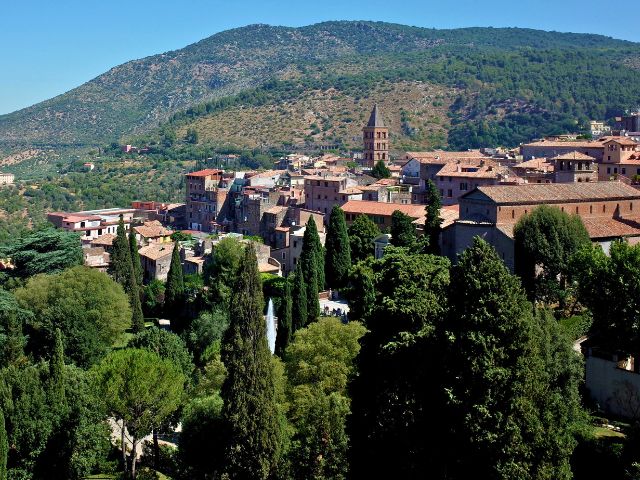 Considering visiting Villa d’Este in the late afternoon for incredible views
Considering visiting Villa d’Este in the late afternoon for incredible viewsFor Villa d’Este, you can visit from spring through autumn.
I love visiting in the summer as the layout of the gardens and fountains ensure the environment always feels cool!
I would not recommend visiting in the winter however as often the fountains are switched off for maintenance so you do not get to see these in action.
No matter what season you visit Rome, here are 4 essential things we recommend never leaving home without:
Disclosure: If you make a purchase through a link on this page, I may receive a small commission – at no extra cost to you. Thank you for supporting my site!
Visiting Hadrian’s Villa (Villa Adriana)
What is Hadrian’s Villa?
Welcome to the private home of ancient Roman emperor Hadrian!
This sprawling palace was one of the biggest ever constructed in the history of ancient Rome, and is considered now to be one of the most outstanding villas from the classical age.
Located in the Sabine Hills in the Roman countryside, Villa Adriana is approximately 25km from central Rome.
Despite this, for Emperor Hadrian it was much more than just a home, it was a meeting point where he could run the Roman empire away from the hustle and bustle of the Eternal City.
After the fall of the Western Roman empire in the fifth century CE the villa fell into disuse and was plundered for its valuable building materials and precious artworks.
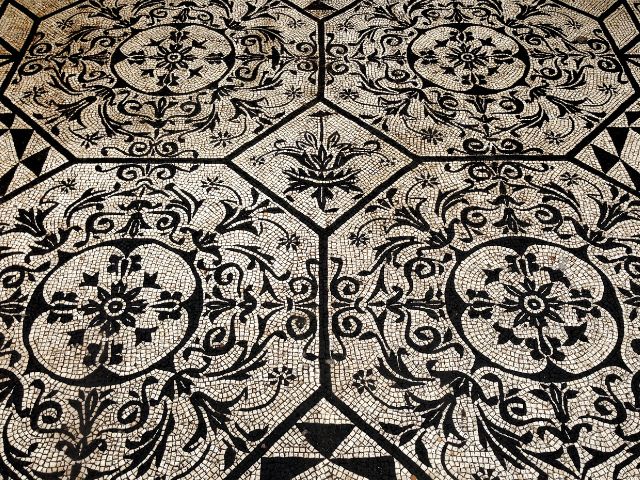 Hadrian’s taste in interior style cannot be faulted – you’ll find preserved and restored mosaics throughout Villa Adriana
Hadrian’s taste in interior style cannot be faulted – you’ll find preserved and restored mosaics throughout Villa AdrianaWhile a lot of what was once here is lost forever, much also survives.
You can see this both on site and in the collections of famous museums around the world, including the Vatican Museums.
Some decorative elements were reused by Cardinal Ippolito d’Este to decorate Villa d’Este which I cover in the next section.
Accessibility
Hadrian’s Villa is a giant open-air archaeological site with modern paths and roads throughout.
These paths and roads are easily traversable for anyone, including those with accessibility challenges, and it is possible to see a large amount of the park this way.
Unfortunately, due to the nature of the ancient ruins, not all the areas within the site are accessible to visitors with mobility restrictions.
Before visiting, I’d recommend contacting Villa Adriana (yourself, or via your tour guide) to discuss any accessibility requirements in advance.
Planning your visit
Hadrian’s Villa covers a HUGE area (200 acres to be exact), making the whole site 130 times the size of the White House!
Many of the key areas to visit are spaced out, so be prepared to walk.
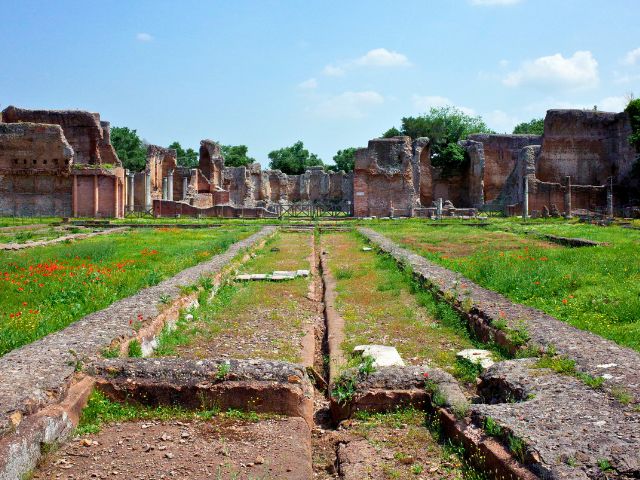 The scale and size of Villa Adriana is simply breathtaking – imagine living here!
The scale and size of Villa Adriana is simply breathtaking – imagine living here!To see the main sites you should allow 3 hours minimum during your day trip from Rome.
If you want to see absolutely everything, you should plan to spend at least 6 hours here.
If you are visiting in the summer, be sure to bring a hat and sun block as the site is very exposed.
Consider also timing your visit for the early morning before the sun gets too hot.
If visiting at any other time of the year, bring a waterproof jacket and umbrella.
The weather in this area of Lazio is very changeable and the site very exposed to the elements.
Always bring plenty of water and something to eat for lunch as on-site refreshment options are limited.
There is a small café/kiosk but the opening hours are inconsistent.
You’ll find endless green spaces with benches where you can rest and recharge, as well as water fountains are dotted around the park.
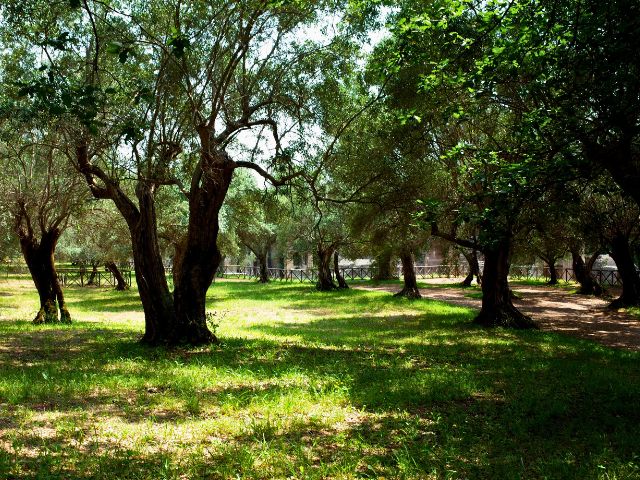 Consider bringing a picnic and finding a quiet spot to enjoy your surroundings – there are rumours that some of the olive trees here are nearly as old as the villa itself!
Consider bringing a picnic and finding a quiet spot to enjoy your surroundings – there are rumours that some of the olive trees here are nearly as old as the villa itself!Ready to plan your trip?
Book your train
Planning to travel between cities in Italy and other parts of Europe?
Use Trainline to see all the different options available across the different rail companies.
Find your hotel
Find your perfect place to stay in Rome.
Use Booking.com to choose between hotels, guesthouses, and self-catering apartments in neighborhoods throughout the Eternal City.
Buy your TurboPass
Purchase the convenient Turbopass and visit all of Rome’s top attractions including the Colosseum, Pantheon, and Vatican.
With one handy pass, it’s all included.
Tickets and opening hours
Tickets can be purchased online or at the ticket office on site.
Booking in advance isn’t generally required as it’s such a large place, but it does allow you to skip the line if there is one.
For up to date opening hours and other information about visiting, check out the official website here.
Must-sees
Visitor welcome center
Before you start exploring, I recommended stepping into this little museum at the welcome center to view the to-scale model of the whole villa site.
Not only does it help orientate you, but it also helps to show the original grandeur and scale of Hadrian’s Villa.
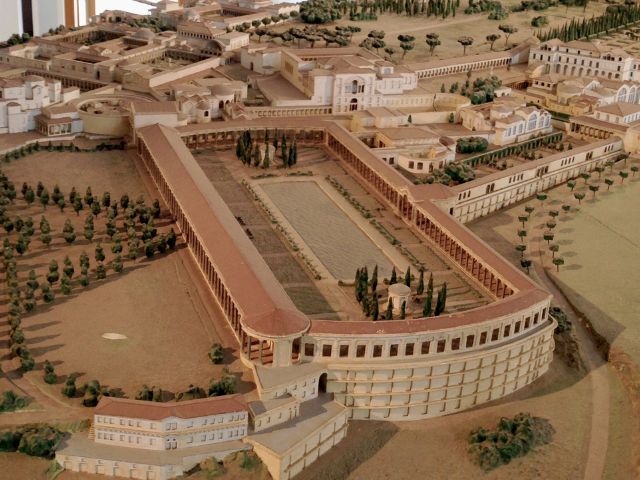 This is the best way to start your visit, to understand the scale of the palace originally
This is the best way to start your visit, to understand the scale of the palace originallyCanopus
This is maybe the most iconic feature of Hadrian’s Villa.
The Canopus was designed to replicate the river Nile in Egypt (hence the crocodile statues) which is where Hadrian’s lover Antoninus died in a tragic accident.
This was Hadrian’s personal and private space where he would come to remember his beloved.
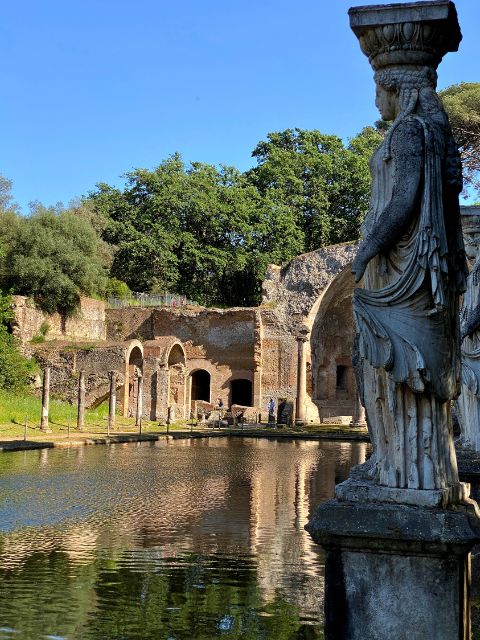 If you are planning on visiting the Vatican Museums while in Rome, be sure to search out the statues found here in their collection!
If you are planning on visiting the Vatican Museums while in Rome, be sure to search out the statues found here in their collection!Maritime theater
So called because of its circular shape and the presence of flowing water, this complex structure was another space thought to be used personally by Hadrian .
The Maritime theater comprised over thirty rooms, all of which would have been intricately decorated.
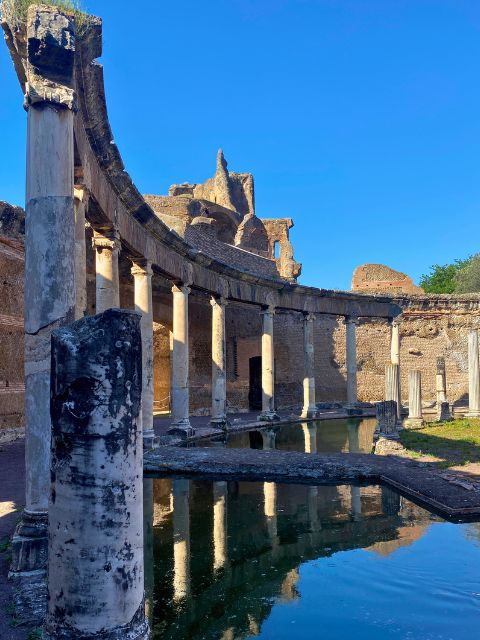 Keep an eye out for the fish!
Keep an eye out for the fish!Museum
Located next to the Canopus, this museum houses a lot of the original statuary that was found at the site which hasn’t been relocated to other museums around the world.
I particularly like getting up close with the crocodiles!
When visiting on a hot day it provides a welcome break from the sun, and you’ll also find bathrooms nearby.
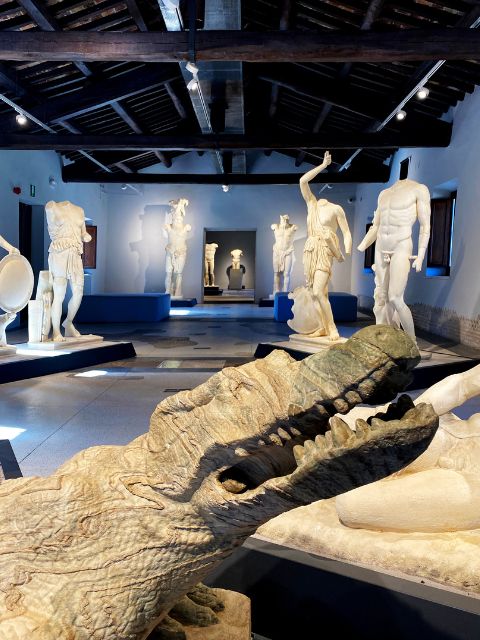 One of the original Nile crocodile statues from the Canopus
One of the original Nile crocodile statues from the CanopusTemple of Venus
While not much remains of this temple, its outlying location makes it worth visiting as it helps to put the size of the site into context.
I also find the location of the Temple of Venus on the edges of the park and the surrounding views evocative and peaceful.
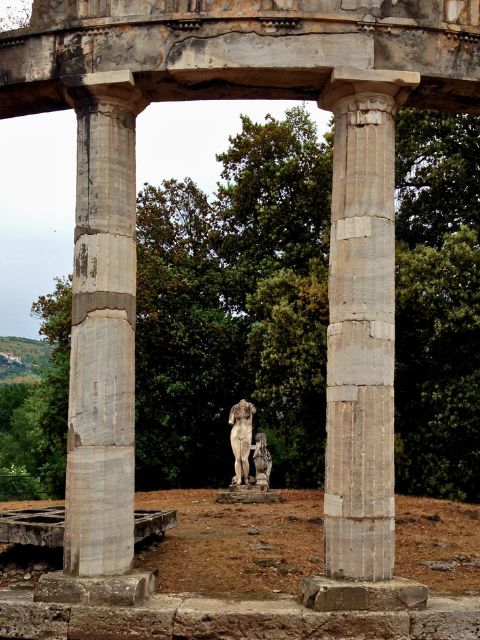 Chances are that you’ll be the only visitor to the Temple of Venus as not many people make it here!
Chances are that you’ll be the only visitor to the Temple of Venus as not many people make it here!Visiting Villa d’Este in Tivoli
What is the Villa d’Este?
Welcome to the private villa and its beautiful gardens (and now resting place) of Cardinal Ippolito d’Este.
Cardinal d’Este began work in 1560, 11 years after he was appointed as governor of Tivoli in 1549, following an unsuccessful attempt to become Pope.
He would go on to make five bids for the papacy, none of which were successful!
Following his passion for antiquity, the cardinal removed a lot of the remaining statuary, ancient artworks and marble from Villa Adriana in order to construct and decorate his new home.
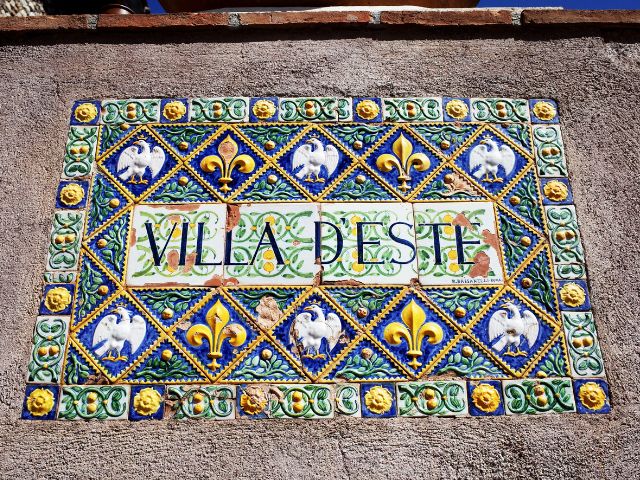 This ornate welcome sign is just a taste of the opulence inside!
This ornate welcome sign is just a taste of the opulence inside!The primary construction took place over 9 years, during which time a lot of the terraced gardens, grottoes and fountains you see today were created.
In the subsequent centuries further elements were added by his descendants, and older parts renovated but for long periods the villa and gardens were abandoned.
After World War I the Italian state took control of the site and initiated a program of restoration, meaning this incredible place can be enjoyed today.
Accessibility
Villa d’Este features a vast open-air garden constructed on the side of a large hill.
Navigating the gardens is done via ramps and slopes, or stone staircases, which means they are not suitable for wheelchair users or those with limited mobility.
There is a golf cart route which allows people who would otherwise not be able to visit the gardens see some of the main features.
Take a look at the official site here for more details.
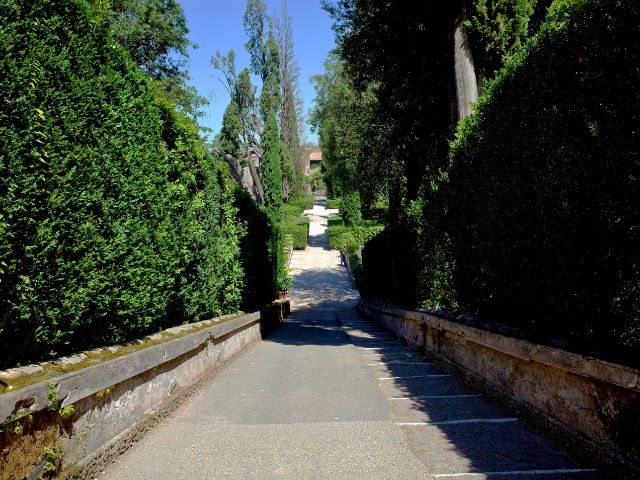 Some of the original stairs have been updated to feature ramps, but be aware that these are very steep in places.
Some of the original stairs have been updated to feature ramps, but be aware that these are very steep in places.Planning your visit
Visitors should allow at a minimum two to three hours to fully explore the gardens and fountains.
The best time of day to visit Villa d’Este is in the afternoon.
This is especially good in the summer as the shade from the gardens and moisture from the fountains ensures the paths are lovely and cool.
Bring water and snacks as there are very limited food options on site.
The gardens are very central however so there are plenty of places nearby to have a coffee, gelato or lunch before or after your visit.
Tickets can be purchased online or at the entrance along with audio guides.
What to see in the villa
Villa d’Este is an enclosed site, meaning it’s easy to navigate and see everything here if you follow the signs and recommended itinerary. My personal highlights of any visit include:
The villa
You’ll enter the contrary to how Cardinal d’Este designed.
Originally visitors would come to the base of the gardens and slowly make their way up the hill to his home, demonstrating to them his power and wealth.
When you enter now you have the opportunity to explore the Cardinal’s private residence where you’ll find ornately decorated rooms.
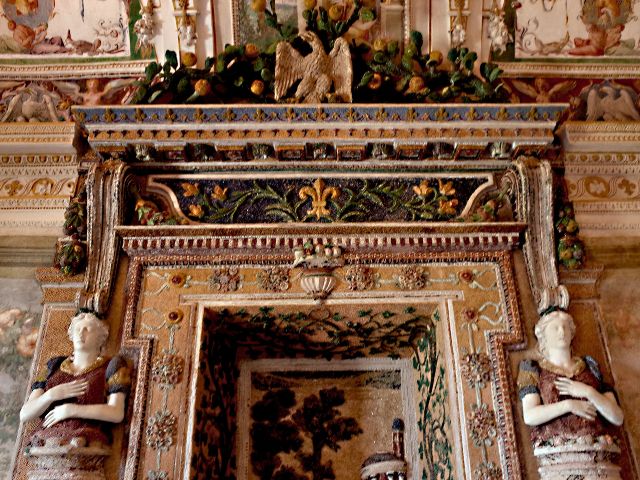 A villa fit for a cardinal, and his descendants
A villa fit for a cardinal, and his descendantsThe Fountain of the Organ
This fountain is probably the most famous in the garden, as it is the oldest example of a hydraulic organ.
Via a complex and delicate system, water and air is piped through a hidden network and used to create musical notes and sounds.
Over the course of its life it has been repaired and upgraded several times, with the most recent renovation being in 2003, meaning its magical sounds could be heard once again after a long period of silence.
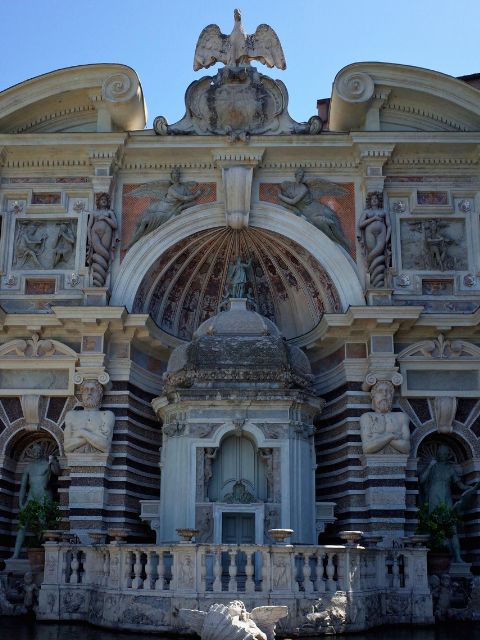 It might not ‘look’ musical, but don’t let its design fool you – just listen!
It might not ‘look’ musical, but don’t let its design fool you – just listen!The Fountain of Neptune and Fish Ponds
This fountain is one of the more modern features of the garden, created in the 20th century to replace elements that had fallen into disrepair.
The fish ponds you can see here once served a practical purpose, providing the villas residents and staff with fish and other animals for food.
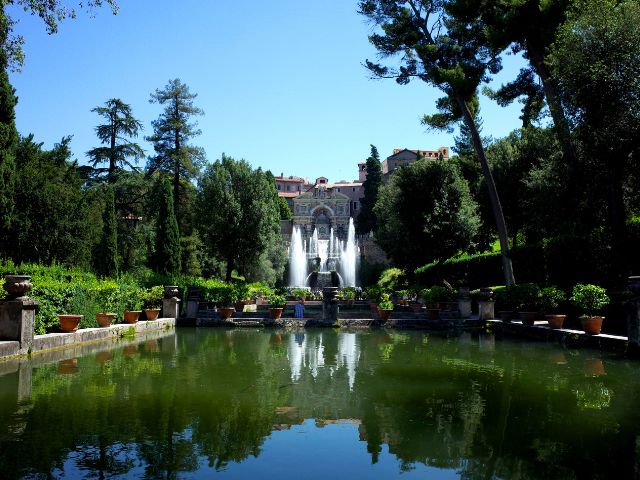 The scale and luxury of Villa d’Este becomes truly apparent when you are down here
The scale and luxury of Villa d’Este becomes truly apparent when you are down hereWhat else to see in Tivoli
If you find yourself with free time when in Tivoli, or are looking to explore further, considering visiting these sites and monuments.
These are just a selection of my favorites, as there is much more to be found:
- Villa Gregoriana, a large park where you can get close to Tivoli’s famous waterfalls and explore ancient grottoes. It was commissioned by pope Gregory XVI in and today the Villa Gregoriana is looked after by the Fondo Ambiente Italiano, the National Trust of Italy.
- Sanctuary of Hercules Victor, a vast ancient Roman temple complex dedicated to Hercules with a theatre built in to the slope of the hills.
- Temple of Vesta and Temple of the Sybil (find out how to see these for free – continue reading!) on Tivoli’s ancient acropolis – you can get a great view of these from Villa Gregoriana.
- Rocca Pia – this imposing castle in the centre of Tivoli was built by pope Pius II in 1461 to control the local area.
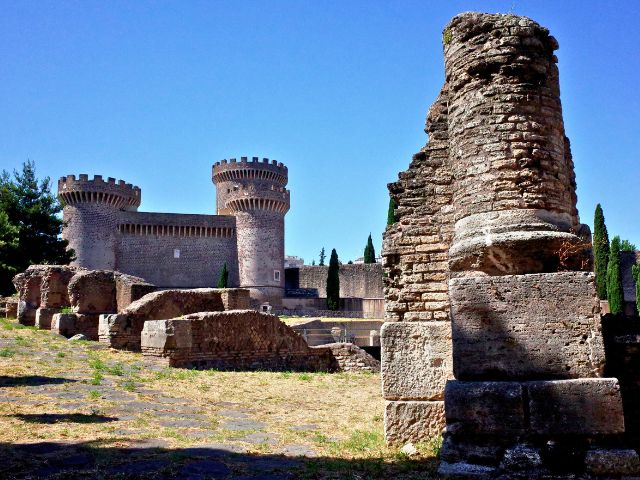 First a papal fortress and then a prison, Rocca Pia has had a fascinating history
First a papal fortress and then a prison, Rocca Pia has had a fascinating historyIf you are visiting with a tour guide or private guide that provides transport from Rome, be sure to ask them to ask them to take you past the ruined ancient aqueducts on the outskirts of Tivoli.
Where to eat and drink in Tivoli
For me, there is one place which is a must-visit for food and drinks in Tivoli; Ristorante Sibilla.
Perfect for a traditional Italian lunch and/or dinner and located only 10 minutes walk from Tivoli’s main square (Piazza Garibaldi), this restaurant is renowned for its high quality, seasonal menu.
It has been the choice dining location for many of history’s most famous figures, including Neil Armstrong, Yoko Ono and Princess Margaret of Great Britain.
When you arrive you’ll see what else also makes this restaurant special; from its outdoor terrace you can marvel up-close at the ancient ruins of the Temple of Vesta and Temple of the Sybil.
If that wasn’t enough, looking the other way you’ll be treated to incredible views of Tivoli’s famous waterfalls and a special view of this beautiful town.
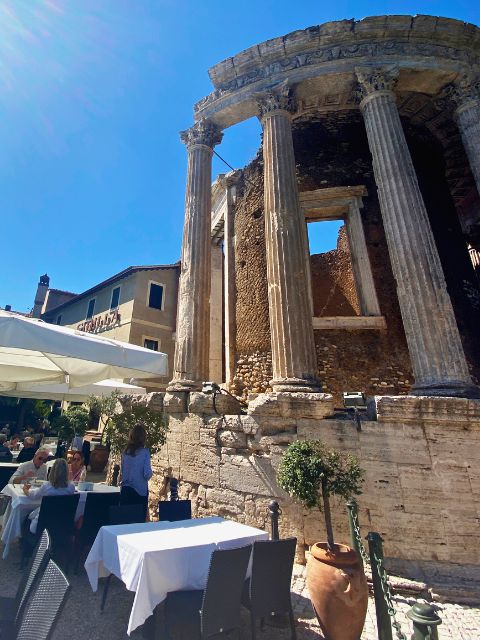 Dine with a view at Ristorante Sibilla on your day trip
Dine with a view at Ristorante Sibilla on your day tripIf you are on a guided tour of Tivoli and don’t have time to visit Ristorante Sibilla, I’d recommend making a separate day trip from Rome to Tivoli just to eat here and take in the views!
Want to save this to Pinterest? Pin it here!
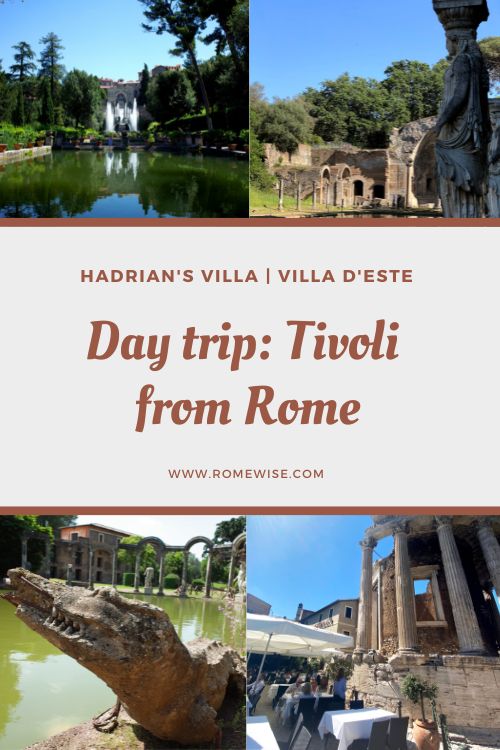
Romewise’s Top Travel Resources
Ready to book your trip to Rome? Take a look at these helpful links to companies we use and trust:
Within this post there are some affiliate links for products and services. For more details about our affiliate policy click here.
Get your 100% free Rome trip planner now!
Simply sign-up today for our free newsletter and get the Romewise Quick Start guide to Rome:
We are committed to respecting your data. Click for our Privacy Policy.
Comments? Questions? Suggestions?
Please come over to the private Romewise Facebook group and join in the conversation.
You will often find me there, happy to answer your questions / comments!
You will also meet other Rome lovers and experts, too.
What are you waiting for?









